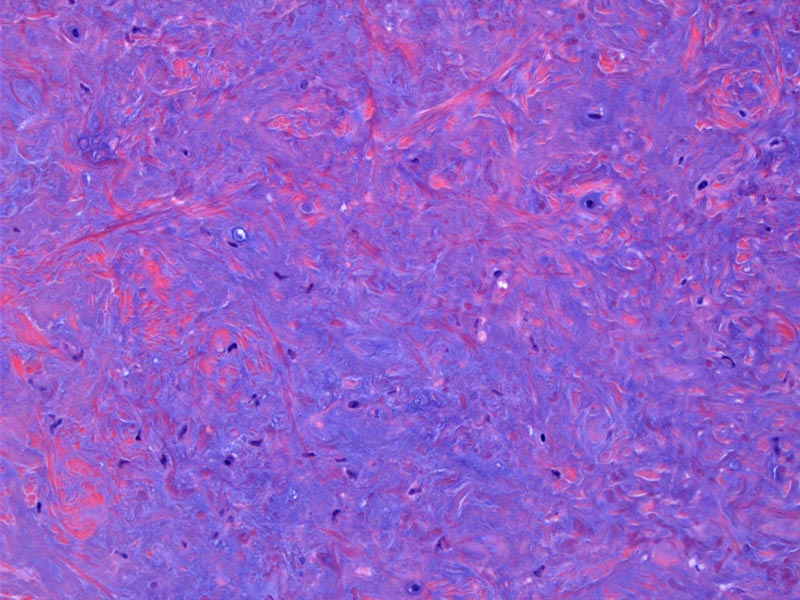

In this image, small rim shows benign myxohyaline stroma and a few cells consistent with background of a benign pleomorphic adenoma. Identifying the benign component is a necessary prerequisite for the diagnosis.
Malignant cells infiltrating through glands are seen in this image.
Dense stroma, malignant epithelial cells, and pink cytoplasm are found in this example of of CXPA.
A second example shows a nice example of pleomorphic adenoma, with myxohyaline material abutting a more unusually cellular area of benign tumor
Other areas show dissecting clusters of tumor cells irregularly mingling with the salivary stroma
Some solid sheets of tumor cells within a sclerotic stroma are also present and are clearly malignant.
And finally, some of these tumor cells were found in a periglandular lymph node.
Carcinoma ex pleomorphic adenoma(CXPA) is a malignancy arising from a preexisting pleomorphic adenoma. These tumor comprise about 10-15% of salivary malignancies and about 5% of all salivary gland neoplasms. The carcinoma type is broad, and includes adenocarcinoma, myoepithelial carcinomas, and anaplastic carcinoma. It often requires 15-20 years of existence of pleomorphic adenoma before development of the malignant counterpart.
For prognostic importance, CXPA is subdivided into categories of
- Non-invasive (carcinom in-situ)
- Minimally invasive (<1.5 mm invasion into surrounding extra-capsular tissue
- Invasive (>1.5 mm invasion)
The location of these tumors mirrors benign pleomorphic adenomas with about 75% arising in the parotid and age distribution about a decade later(6th to 7th decade). Typically CXPAs present with rapid growth of a mass present for several years. They may also present with skin invasion and facial invasion.
For invasive disease, the treatment of choice is total parotidectomy and cervical lymphadenectomy. Facial nerve sacrifice is mandated only in cases with preoperative facial nerve palsy or clear encasement of the nerve. Adjuvant radiation therapy is typically employed in invasive disease as well. Cases of noninvasive or minimally invasive disease have significantly lower metastatic potential but are typically managed similarly with total parotidectomy and lyphadenectomy if the diagnosis of CXPA has been established preoperatively.
Non-invasive and minimally invasive tumors have an excellent prognosis. Prognosis for the invasive subtype is significantly worse with long-term survival less than 50%. This underscores the importance of accurate tumor subtyping.
• Salivary Gland : Pleomorphic adenoma
• Salivary Gland : Pleomorphic adenoma
1 Malignant mixed tumors of the salivary glands: a review. Pathol Annu 28 Pt 1: 279-328.
2
3
4
5
6